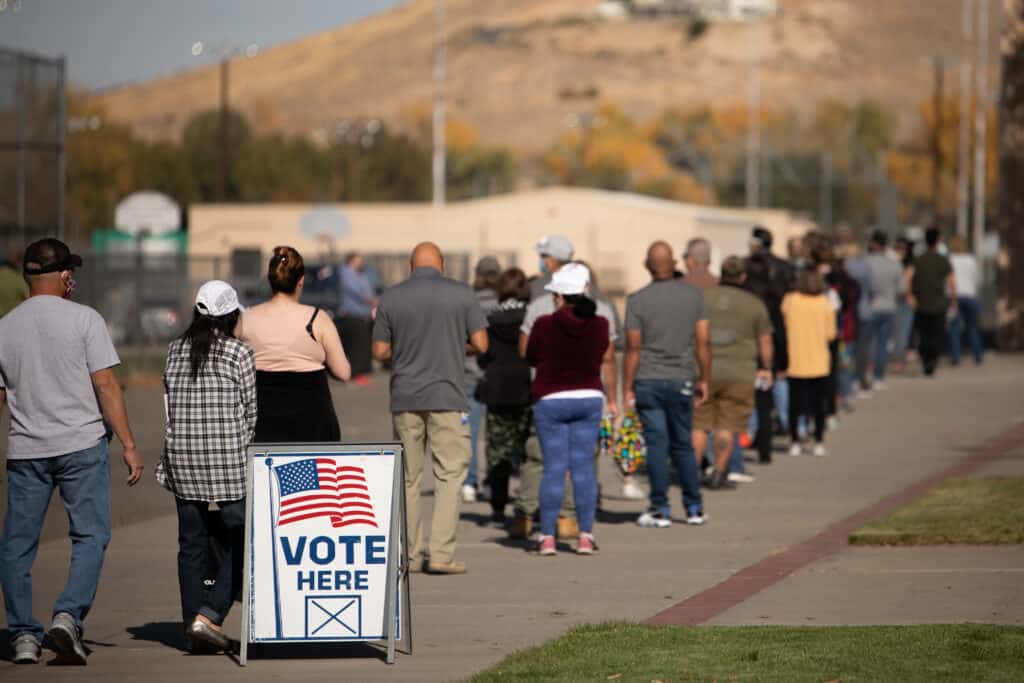
Republicans didn’t ride a “red wave” into power, but they’re still poised to win a slim House majority come January – if not control of the Senate, too. With a Democrat in the White House and more Republicans in Congress, will anything get done in Washington, D.C.?
To discuss divided government and other takeaways from the midterms, we spoke with three experts from the USC Sol Price School of Public Policy: Elizabeth Currid-Halkett, the James Irvine Chair in Urban and Regional Planning and a professor of public policy; Jeffery A. Jenkins, Provost Professor of Public Policy, Political Science and Law; and Mindy Romero, research assistant professor and director of the USC Price School Center for Inclusive Democracy.
Can we get anything done with a divided federal government? What does history tell us?

Jenkins: You’ve been able to get things done in divided government in the past. If you look back to the 1990s under President Clinton, he was able to work with the Republican Congress pretty well. The total gridlock really started during the Obama administration when the Republicans essentially said, “We’re going to go all-in on saying no to everything rather than try to work with him.” It paid off for them, and I think that’s the playbook right now: to essentially not negotiate with the opposition party, to not try to collaborate with the opposition party and to essentially grind things to a halt and then blame the opposition party for nothing getting done.
Romero: Individual Congress members’ loyalties are split in so many different ways, and often it’s not the Republican leadership and maybe not even their constituents. But it’s amplified by social media and the fragmentation we’ve seen generally across the country and the polarization of parties that we’ve seen. Individual members are looking for a sound bite, looking to make national headlines, looking to get donors from across the country but from powerful segments, and PACs to support them in ways that just mean that they function and operate differently than we’ve seen historically.
Currid-Halkett: We’ve seen Washington in gridlock for a long time now. The legislative process wasn’t exactly super well-oiled prior to the midterms. Even when the Democrats controlled the whole trifecta, it wasn’t the case that they were getting everything they wanted. Part of this dynamic has to do with Republican lawmakers stymying efforts to pass Democratic legislation. But even within the Democratic Party we’ve seen so much infighting that has equally cost them some pretty important legislation.
Are there any policy areas where Congress can find common ground?

Jenkins: Nothing that would be considered landmark policy or major policy. You could imagine some sort of policy that would cut across the grain ideologically or the partisan landscape. It could be something like immigration, where there would be people on either side of the aisle that would have reason to cooperate. But I think that, especially because Republicans probably will only have one chamber, that their best play is to just essentially say “No” and try to move forward from there.
How did the issue of reproductive rights affect the midterms?
Currid-Halkett: According to Pew, something like 85 % of Americans support some or all rights to an abortion, so it’s not actually a party line split. The people who wholly do not support it are very much on the fringe and that’s not most people in America. We saw what happened in Kansas, a historically conservative state. There was a rebuke of the Supreme Court’s decision and voters decided to keep abortion legal. Between the rejection of extreme right candidates and the general population’s desire to uphold abortion rights, my guess is that these factors explain the lack of a “red wave” and why we saw a country the next day that looked largely the same as it did the night before.
Romero: Exit polls and other surveys are saying that abortion was a leading factor in the decisions that many voters made, and you can’t ignore that. We saw it in terms of actual initiatives on the ballot and we also saw it in terms of what motivated voters to cast their ballots. It’s going to be interesting how the Republican Party reacts to the impact of abortion in the 2022 midterm.
Jenkins: [Governor] Ron DeSantis did really well in Florida and his position on abortion was more moderate than the conservative wing of the Republican Party. It would be interesting to see if people look into DeSantis’ win and think about whether that’s the best-case policy for the Republicans in 2024, to take a little bit softer position on abortion.
What happened with the youth vote?

Romero: It’s not like it shot through the roof and young people all of the sudden turned out as high as older voters. We’re talking about a few percentage points higher. We’ll be glad for that. That means a larger youth voice, that’s progress. But it’s kind of a double-edged sword. We want to support young people. We want to recognize the power of the youth vote. A big part of that is you want campaigns to think of young people as actually in play and compete and vie for their vote. So you want to celebrate those numbers, but at the same time we want to be realistic because young people still need a lot more resources.
Are we as polarized as the pundits say we are?
Currid-Halkett: I find the polarization conversations a little bit misleading because you do only get to vote for one person or one party. It is binary. Is it polarization, or is it simply Democrats stuck with Democrats and Republicans stuck with Republicans? Is that polarization or simply party affiliation? There is a truth that there are not as many swing voters as there might have historically been, but I don’t think that’s the same thing as a radical reaction from most Americans. Those people exist, but they are not the majority.